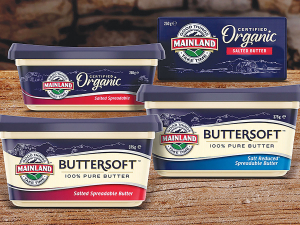Revamped Fonterra to be ‘more capital-efficient’
Fonterra chair Peter McBride says the divestment of Mainland Group is their last significant asset sale and signals the end of structural changes.
 New Zealand sells products like butter to all its customers – whether they’re based in New Zealand or offshore – largely at the same price.
New Zealand sells products like butter to all its customers – whether they’re based in New Zealand or offshore – largely at the same price.
Kiwis love their butter, and that's great because New Zealand produces some of the best butter in the world. But when the price of butter goes up, it's tough for some, particularly when many other grocery staples have also gone up and the heat goes on co-operative Fonterra, the country's main butter maker. Here the co-op explains why butter prices are so high right now.
The main driver of the price consumers ultimately pay for butter is global prices.
Now, these prices are the highest they've been in more than five years. Strong global demand is one of the factors influencing the wholesale price of butter.
Retailers ultimately set the shelf price, but companies that sell to them buy butter at a wholesale price driven by the globally traded price from Fonterra and other suppliers.
So, who sets the global price? The global price of butter reflects demand from around the world, from China to the Middle East, and also the supply from butter exporters, not just in NZ but globally. Like other globally traded products – like coffee – global dairy prices go up and down.
Why doesn't domestic demand set the price?
New Zealand exports 95% of all its dairy products and sells products like butter to all its customers – whether they’re based in New Zealand or offshore – largely at the same price. This means the international market for dairy sets our price in New Zealand.
In some countries larger than New Zealand, where their dairy products are largely consumed domestically rather than exported, the price of their products is determined by domestic demand rather than global demand.
Why can't we sell it to New Zealanders for less?
As a farmer owned cooperative, Fonterra’s role is to collect, process and sell farmers’ milk to customers here in New Zealand as well as globally, working to get the best price they can for their farmers. Selling it for less would mean a business choosing to sell at a loss or giving a subsidy. That’s not a sustainable model for any business long term, particularly when they compete in global markets.
Is butter cheaper in supermarkets overseas?
It’s not always. And it’s really important that when prices are compared, currencies are converted so we’re looking at like for like. It’s also important to consider if the butter is in the same size format for example, in some other countries, 250g blocks are more common than the 500g seen in New Zealand.
The difference in price can be driven by a number of things, including whether the price is set by the international market or domestic market.
Tax is also applied differently in different markets. For example, in Australia they don’t have GST on butter. If you take GST off the New Zealand price and convert it to New Zealand dollars, a similar block of butter is often cheaper in New Zealand than in Australia.
How is the cost of NZ butter made up?
Fonterra is focused on keeping the costs they can control as efficient as possible.
The cost of butter varies between different brands and formats. However, if we take a 500g block of butter that’s being sold for $8.60 around 80% of this cost comes from the global butter price, and the cost to cut, wrap, store and distribute the product to the retailer.
Then there's the margins added by producers, distributors and retailers, plus all the costs to get the product from the distribution centre and onto the retailer’s shelf, and finally GST is added onto this to come to the final selling price.
The National Wild Goat Hunting Competition has removed 33,418 wild goats over the past three years.
New Zealand needs a new healthcare model to address rising rates of obesity in rural communities, with the current system leaving many patients unable to access effective treatment or long-term support, warn GPs.
Southland farmers are being urged to put safety first, following a spike in tip offs about risky handling of wind-damaged trees
Third-generation Ashburton dairy farmers TJ and Mark Stewart are no strangers to adapting and evolving.
When American retail giant Cosco came to audit Open Country Dairy’s new butter plant at the Waharoa site and give the green light to supply their American stores, they allowed themselves a week for the exercise.
Fonterra chair Peter McBride says the divestment of Mainland Group is their last significant asset sale and signals the end of structural changes.